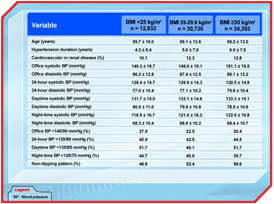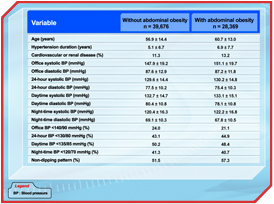By Alejandro de la Sierra, MD
Luis M. Ruilope, MD
Hypertension Units, Hospital Clinico, Barcelona & Hospital 12 de Octubre, Madrid, Spain
asierra@clinic.ub.es
ruilope@ad-hocbox.com


Introduction
It has been clearly established that hypertension prevalence is increased in overweight and obese subjects. Mechanisms leading to increased blood pressure in obesity include sympathetic overactivity, insulin resistance and sodium retention [1].
Differences in fat deposition and distribution seem to have a different impact on cardiovascular disease. Excess intra-abdominal (visceral) adiposity is detected by increased waist circumference and is often accompanied by disturbances in lipoprotein metabolism (increased VLDL and decreased HDL) [2] and other alterations in blood pressure and insulin sensitivity in the context of what is called the "metabolic syndrome" [3]. The latter's relationship with cardiovascular disease has proven to be closer than that observed with simple increases in body weight [4].
The evidence regarding the relationship of fat accumulation and distribution abnormalities with ambulatory blood pressure monitoring (ABPM) is scarce and has been limited to either children [5] or small cohorts [6]. In this preliminary analysis, we investigated both clinical and ABPM in a large cohort of hypertensives, divided into body mass index (BMI) and waist circumference categories.
Patients and Methods
Study design
The Spanish Society of Hypertension ABPM Registry was developed to promote the use of ABPM in clinical practice. As part of the ABPM Registry initiative, more than 900 Spacelabs 90207 ambulatory blood pressure (BP) monitors (Spacelabs Inc., Redmond, WA, USA) were distributed for routine use by physicians in primary care centres and specialized units. Details of physicians' recruitment and registry characteristics have been reported previously [7-11]. Briefly, physicians and nurses received specific training on the ABPM technique and used the web-based platform for ABPM registries together with their corresponding medical records. Physicians then received a results report in real time, with registries being stored in a database hosted by an external clinical research organization. The protocol was approved by a series of institutional review boards in autonomous communities across Spain, and patients gave informed consent. The registry is growing continuously and receives data from approximately 1,500 patients per month, with the first patient recruited in June 2004. For the purpose of the present study, 68,045 hypertensive patients recruited by 1,126 physicians between June 2004 and December 2007 were selected.
BP measurements
BP was measured at the office with a calibrated mercury sphygmomanometer or a validated semiautomatic oscillometric device, after a 5-minute rest in a sitting position. BP values were estimated as the mean of two readings. Thereafter, 24-hour ABPM was performed using the Spacelabs 90207 automated non-invasive oscillometric device, programmed to register BP at 20-minute intervals for the 24-hour period. Valid registries had to meet a series of pre-established criteria, including ≥80% successful recordings of systolic BPs and diastolic BPs during the daytime and night-time periods, 24-hour duration and at least one BP measurement per hour. Daytime and night-time periods were defined individually according to patients' self-reported data regarding going-to-bed and getting-up times.
Study variables
Variables collected for each patient based on the interviews and physical examination at the time of visit and on data drawn from clinical records were defined and measured in accordance with national and international guidelines [12, 13]. These included age, gender, weight, height, BMI, waist circumference, duration of hypertension, known cardiovascular risk factors and clinical cardiovascular or renal disease (coronary heart disease, congestive heart failure, peripheral artery disease, cerebrovascular disease, chronic renal failure).
Statistical analysis
Data was presented as frequencies and percentages for qualitative variables and as mean ± standard deviation for quantitative variables. Differences in study variables among prespecified groups of BMI (<25, 25-29.9 or ≥30 kg/m2) or among patients with and without abdominal obesity (waist circumference >102 cm in men and >88 cm in women) were assessed with the Pearson x2 for qualitative variables and one-way ANOVA or Student's t test for quantitative data.
Results
Differences in clinical and ABPM depending on BMI groups
From the total cohort of 68,045 patients, 12,932 (19%) exhibited BMI values <25 kg/m2, 30,720 (45.1%) values between 25 and 29.9 kg/m2 and 24,393 (35.8%) were considered obese (≥30 kg/m2). As shown in Table 1, a progressive increase in clinical and ambulatory systolic BPs was observed with increased BMI values. In contrast, diastolic BP showed minimal or no changes. The magnitude of BP increase with higher BMI values was clearly more pronounced in office, compared with ambulatory blood pressure (ABP), and the proportion of patients showing normal 24-hour and daytime BP values did not differ clearly among BMI categories, with the exception of nocturnal hypertension, which was higher in obese subjects. The prevalence of a normal dipping pattern was also reduced in obese hypertensives, compared with hypertensives with normal BMI.
Other differences observed in patients with increased BMI included older age, longer duration of hypertension and a higher prevalence of cardiovascular or renal disease (Table 1).
 [Click to enlarge]
[Click to enlarge]
Differences in clinical and ABPM depending on waist circumference
Abdominal obesity, defined using the aforementioned criteria, was present in 28,369 hypertensive subjects (41.7%). Table 2 shows the clinical and BP differences between patients with and without abdominal obesity. As with BMI, clinical and ambulatory systolic BP were increased in patients with abdominal obesity, whereas diastolic BP was lower. Similarly, the magnitude of BP increase with higher values of waist circumference was clearly more pronounced in office, compared with ABP, and the proportion of patients showing normal 24-hour, daytime and night-time BP values did not differ clearly among those with and without abdominal obesity. Despite this, the prevalence of a normal dipping pattern was reduced in abdominally obese hypertensives.
Other differences observed in patients with increased waist circumference also included older age, longer duration of hypertension and a higher prevalence of cardiovascular or renal disease (Table 2).
 [Click to enlarge]
[Click to enlarge]
Discussion
The present data shows that obesity, as measured by BMI, or abdominal obesity, as measured by waist circumference, has a definite impact on office or clinical BP measurements, with obese or abdominally obese subjects exhibiting significantly higher values of systolic BP when compared with their counterparts with normal BMI or waist circumference. This relationship is, however, minimized when ABPM is examined. In fact, the differences are half those observed with office BP. Moreover, the proportion of patients whose BP is controlled using the respective cut-offs for office, 24-hour, daytime and night-time BP differs if office or ABPM is used. For office BP, subjects with obesity or increased waist circumference show consistently lower rates of BP control. In contrast, with regard to ABPM, control rates for 24-hour and daytime are not different among groups, and for night-time values, only obese, but not abdominally obese hypertensives, show lower control rates than their counterparts. In patients with high BMI or waist circumference, there were no differences or even lower values for diastolic BP.
These results seem to indicate that a more pronounced whitecoat effect is present in obese hypertensive subjects, an hypothesis already postulated in a previous paper derived from the same cohort [8]. The reasons for obesity or abdominal obesity's minimal impact on ABPM are speculative but could be related to several factors, including a lack of physical activity, a limited therapeutical coverage of drugs administered once a day or an incorrect use of normal size cuffs in large arms. Other confounding factors, such as older age and female sex, also related to this enhanced whitecoat effect, may be partially responsible for the discrepancies between office and ABP.
Another important issue in obese or abdominally obese subjects is an increase in nocturnal BP and a greater frequency of a blunted nocturnal fall in BP (a non-dipping pattern), also suggested in a previous analysis [9]. This is even more important in terms of cardiovascular prognosis and also indicates that antihypertensive treatment, administered once a day in most of these patients, does not cover the therapeutical window of 24 hours. It has been previously demonstrated that both nocturnal hypertension and a blunted nocturnal BP fall are linked to a worse cardiovascular prognosis [14, 15].
In conclusion, ABPM seems to add important clinical information to the management of obese hypertensive patients. The detection of both an enhanced whitecoat phenomenon and the presence of nocturnal hypertension or a non-dipping pattern could be relevant in terms of choosing the best therapeutical options for optimal cardiovascular protection.
References
- Mikhail N, Golub MS and Tuck ML. Obesity and hypertension. Prog Cardiovasc Dis 1999; 42: 39-58.
- Després JP and Lemieux I. Abdominal obesity and metabolic syndrome. Nature 2006; 444: 881-7.
- Grundy SM, Cleeman JI, Daniels SR, et al. Diagnosis and management of the metabolic syndrome: an American Heart Association/National Heart, Lung, and Blood Institute Scientific Statement. Circulation 2005; 112: 2735-52.
- Galassi A, Reynolds K and He J. Metabolic syndrome and risk of cardiovascular disease: a meta-analysis. Am J Med 2006; 119: 812-9.
- Lurbe E, Torro I, Aguilar F, et al. Added impact of obesity and insulin resistance in nocturnal blood pressure elevation in children and adolescents. Hypertension 2008; 51: 635-41.
- Helvaci MR, Kaya H, Yalcin A, et al. Prevalence of white coat hypertension in underweight and overweight subjects. Int Heart J 2007; 48: 605-13.
- Banegas JR, Segura J, de la Sierra A, et al. Gender differences in office and ambulatory control of hypertension. Am J Med 2008; 121: 1078-84.
- Banegas JR, Segura J, Sobrino J, et al. Effectiveness of blood pressure control outside the medical setting. Hypertension 2007; 49: 62-8.
- de la Sierra A, Redon J, Banegas JR, et al. Prevalence and factors associated with circadian blood pressure patterns in hypertensive patients. Hypertension 2009; 53: 466-72.
- Gorostidi M, Sobrino J, Segura J, et al. Ambulatory blood pressure monitoring in hypertensive patients with high cardiovascular risk: a cross-sectional analysis of a 20,000-patient database in Spain. J Hypertens 2007; 25: 977-84.
- Vinyoles E, Felip A, Pujol E, et al. Clinical characteristics of isolated clinic hypertension. J Hypertens 2008; 26: 438-45.
- de la Sierra A, Gorostidi M, Marin R, et al. [Evaluation and management of hypertension in Spain. A consensus guide]. Med Clin (Barc) 2008; 131: 104-16.
- Mancia G, De Backer G, Dominiczak A, et al. 2007 Guidelines for the Management of Arterial Hypertension: The Task Force for the Management of Arterial Hypertension of the European Society of Hypertension (ESH) and of the European Society of Cardiology (ESC). J Hypertens 2007; 25: 1105-87.
- Dolan E, Stanton A, Thijs L, et al. Superiority of ambulatory over clinic blood pressure measurement in predicting mortality: the Dublin outcome study. Hypertension 2005; 46: 156-61.
- Ohkubo T, Hozawa A, Yamaguchi J, et al. Prognostic significance of the nocturnal decline in blood pressure in individuals with and without high 24-h blood pressure: the Ohasama study. J Hypertens 2002; 20: 2183-9.



